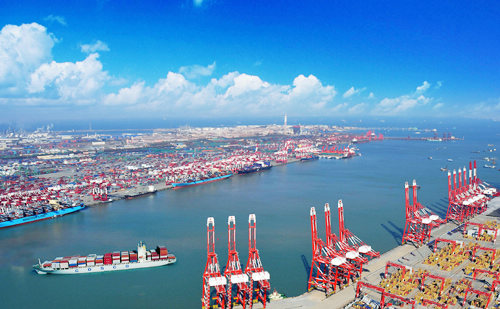|
 |
|
NEXT TOP PORT: The Qingdao port, founded in 1892, is the world's 10th largest port in terms of annual handling capacity (XINHUA) |
Jiang said Shandong is home to nearly 60 marine-related research and educational institutions at both national and provincial levels, accounting for more than 70 percent of the country's total, including the Ocean University of China and Institute of Oceanology of CAS. More than 60 percent of the country's senior researchers of marine science are in Shandong, including 23 academicians of the CAS and the Chinese Academy of Engineering (CAE).
The province also has world leading technologies in marine disaster monitoring and forecasting, marine erosion protection, breeding of aquatic varieties, extraction of marine active substances, marine microalgae energy and sea cell fiber. The technologies of marine pharmacy based on biochemical engineering, enzyme engineering and cell engineering are also at the national advanced level.
"Centering on constructing a modern oceanic industrial cluster of strong international competitiveness, the Development Planning for Shandong Peninsula Blue Economic Zone has selected 14 industries to give priority, such as modern fishing industry, marine bio industry, marine energy and minerals, marine transportation and logistics and marine cultural tourism," Jiang said.
Located in the south of Shandong Province and with South Korea just across the Yellow Sea, the city of Qingdao has a coastline of 711 km, 69 islands and 49 natural harbors. According to Li Qun, Mayor of Qingdao, the city's economic volume accounts for 30 percent of the total of the Shandong Peninsula Blue Economic Zone, and its output value of marine industries contributes 25 percent to the entire zone. More than 50 percent of the national-level ocean-related scientific research projects are carried out by Qingdao.
Liu Mingjun, Director of the Qingdao Municipal Development and Reform Commission, said the city has 28 marine research institutes, more than one third of the country's total, and 20 key laboratories at the ministerial level. It has 19 CAS and CAE academicians.
In 2010, Qingdao's marine-related industries had an output value of 168.3 billion yuan ($26.63 billion), up 17.43 percent year on year, and the output value in marine equipment manufacturing reached 35 billion yuan ($5.54 billion).
Liu said by 2015 the city will achieve added value of 115 billion yuan ($18.2 billion) for its marine industries, and by 2020, the figure will be 220 billion yuan ($34.81 billion), with an annual growth rate of 14 percent.
According to Liu, there will be some major projects in the city for construction of the Shandong Peninsula Blue Economic Zone, such as Dongjiakou port area. Figures from the Dongjiakou port area show that with a planned area of 70 square km, Dongjiakou port area, one of the four sections for Qingdao Port, is the biggest single port area of China, with a total coastal line of 35.7 km. The 112 planned berths are all deep-water berths, with an aggregate handling capacity of 370 million tons. Of the total, the three specially planned extra large ore berths and three extra large oil berths will fill a gap in the capability of berthing extra large ships in China and will help the port to be the world's most efficient one with the lowest transportation cost.
The rapidly improved infrastructure has attracted many renowned companies from home and abroad. According to figures from the port, 19 large companies have established projects in the port, including Sinopec Group, Mercuria Energy Group Ltd., China Huaneng Group, China Datang Corp. and Suez Group. Large state-owned enterprises and global Fortune 500 companies have invested in nine projects in the port. Investment of all the projects in the port area has totaled 70 billion yuan ($11.08 billion), which can bring cargo handling capacity to more than 100 million tons.
Shandong Peninsula Blue Economic Zone
Area: 159,500 square km of offshore waters and 64,000 square km of land
Population (2010): 33.15 million
GDP (2010): 1.87 trillion yuan ($295.89 billion)
Qingdao: Planned to become the regional economic center, modern service center and cultural center of the eastern coastal area and an international shipping center for northeast Asia by 2020.
Yantai: Planned to be an important manufacturing base, port city, regional center for finance, trade and service and an important national tourist resort.
Weihai: Planned to be established as a bridgehead of the China-South Korea economic belt.
Rizhao: Planned to be an important marine industrial base with the position as bridgehead of the New Asia-Europe Continental Bridge and the access to the sea for cities in south Shandong Province.
Weifang: Planned to focus on the marine chemical industry and modern manufacturing industries.
Dongying: Planned to be an important industrial city of Shandong Province and an ecological-friendly city, based on its petrochemical industry.
Binzhou: Planned to serve as a modern industrial base and commercial center in north Shandong Province focusing on machine manufacturing, textile and printing and dyeing industries.
(Source: Development Planning for Shandong Peninsula Blue Economic Zone) | 